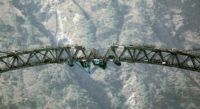Basket-Handle True Arch Crossing Takes Shape

Basket-handle true-arch bridge is the first of its kind over the Mississippi River.
PHOTO COURTESY OF IOWA DOT
One of a pair of basket-handle twin true-arch bridges is now carrying traffic between Illinois and Iowa. The new $1.2-billion Interstate 74 River Bridge is the first of its kind across the Mississippi River, according to the Iowa Dept. of Transportation.
Weather conditions and the complexity of building the arches pushed initial opening of the westbound side from 2019 to 2020, but general contractor Lunda Construction met the modified deadline in November. Work is now underway on the Illinois-bound arch.
The unique site conditions between Moline, Ill., and Bettendorf, Iowa, made the basket-handle design the top choice over a more typical tied arch bridge, says Danielle Alvarez, Iowa DOT project manager. The river level at the location is lower than average for the river, and the bedrock is relatively shallow, which makes the true arch design possible, she says.
The new structures will replace a pair of suspension bridges that were designed for a capacity of 48,000 daily vehicles. In 2016, average daily traffic on the I-74 bridges exceeded 74,000 and is expected to rise to 99,900 by 2035.
Iowa DOT and Illinois Dept. of Transportation whittled down options to four concepts—true arch, tied arch, cable-stayed and through truss. Public input indicated a preference for basket-handle true arch or cable-stayed, and the DOTs with the final design team of Alfred Benesch and Modjeski and Masters selected the former based on aesthetics, construction staging and redundancy.
“Compared to a cable-stayed bridge, the twin basket handle had the advantage of two separate structures,” says Ahmad Abu-Hawash, Iowa DOT chief structural engineer. “If we had to replace one, we can switch traffic to the other side.”
Geotechnical conditions range from fractured and weakly bedded sandstone to monolithic limestone formations. The 239 foundation shafts include pier footings up to 10 ft in diameter and as deep as 50 ft.
There are 30 primary arch segments as part of each basket-handle arch, connected by two intermediate and two main struts. The keystone consists of two arch segments connected by two main struts, installed as one piece.
Each arch segment can weigh up to about 250,000 lb. A crane lifts each segment into position and ironworkers then bolt it into place. Stay cables linked to temporary towers are connected to the third and fifth arch segments on each of the four arch “legs.” The stays are used to support the cantilevered construction.
The Illinois-bound arch now under construction is “more complex because it will support the multiuse path, and so it will require additional considerations regarding the position and geometry of the arch. There are also some site constraints as the Illinois-bound bridge is in between the new and the old bridges,” says Alvarez. Other challenges included protecting and relocating threatened mussel species and avoiding impacts to a nearby downstream dam.
Work is also ongoing on new approaches and improvements to roadways within a 7-mile corridor on both sides of the river, under separate contracts by Civil Constructors, Kraemer North America and Walsh Construction.
“This year, our focus is on completing the eastbound bridge and roadway. The 18th arch segment of 30 was installed on Jan. 23,” says George Ryan, I-74 corridor manager with Wood Environment and Infrastructure Solutions Inc., one of the construction management consultants.
“The eastbound span is being negotiated with the owners for an opening time between November and December of 2021,” said Tutor Perini, Lunda’s parent company, in a statement.



